7:00 French turn
The fog still hung heavily over the battlefield. Ney arrived at Jena with some light cavalry and his avant-garde of light infantry and horse artillery. As he arrived he received the following orders from Napoleon:
Ney’s orders:
-
Primary order: Tactic: march. Objective: move and deploy on and adjacent to the Dornberg hill. Conditions: None
-
Secondary order, if primary order succeeds: Tactic: Attack. Objective: capture Krippendorf.
-
Conditions: If Krippendorf already in French hands deploy to the north-east of it and adopt a defensive position.
-
Secondary order, if primary fails: Tactic: defense. Objective: establish defensive line to the north-east of Closewitz. Conditions: none.
With Lutzeroda, Closewitz and the Dornberg under Lanne’s control he had already fulfilled his primary order form Napoleon. His secondary order was to pursue the Prussians as far as Krippendorf and capture it if possible. Despite the unfortunate routing of the 34th Infantry, Lannes decided to push on towards Krippendorf. The Prussians had been successful so far in falling back before the French, aided by the thick fog, but now their main line was within striking distance. French light cavalry, on the left, rode forward attempting to make contact with the disorganised Prussian cavalry and infantry. Whilst the 21st Chasseurs rode off to cover the French right flank. Lannes led his infantry into contact with the main Prussian and Saxons line. The 17th Light, led by Lannes, and the 88th line, swept aside the skirmishers from the Prussian fusiliers and contacted the Prussian 45th Line and the 7th Fusiliers, who had deployed into line to meet them. Over on the French right, the 21st Light Infantry moved within musket range of the Saxon 3rd Grenadiers and 5th Line. The remaining French infantry were moving rapidly towards the Prussian centre but the fog prevented them making contact.
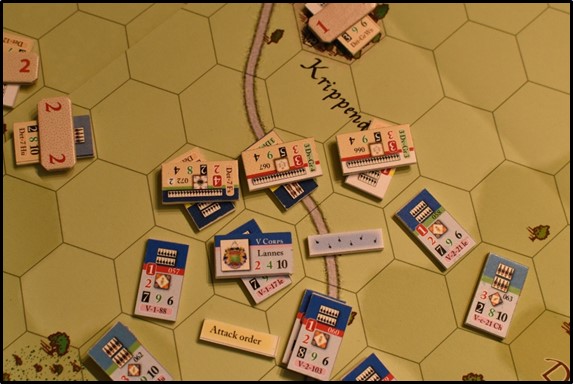
Lannes’ French infantry finally contacted the elusive Prussian forward line.
Elsewhere on the battlefield, Soult’s units continued their deployment and Ney entered the battlefield. Both forces gained a fatigue.
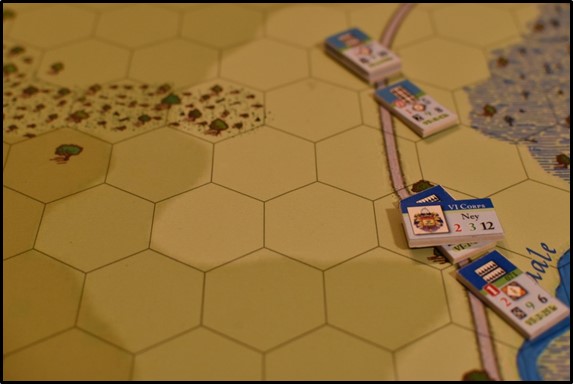
Ney enters the field.
With movement complete, attention returned to Lannes’ Corps and their assault on Taunzien’s forces. The Saxons poured fire into the advancing French causing casualties to the 88th Line & 21st Light Infantry but neither hesitated in their progress. Advancing French fire from their columns and skirmishers did not trouble the Saxons. Again, under Lannes leadership the French assault was unstoppable and disorganised the defending Saxons and forced them to retreat. The 88th Infantry advanced to fill the gap in the Saxon line. The 21st Light Infantry could make no progress against the Saxons on the French right.
Lannes’ Corps gained another two fatigue and now had six. His units were beginning to feel the strain of battle and the corps morale was reduced by 1. Lannes will need to decide next turn whether to continue the attack or disengage and allow his men some respite.
There were no rally actions for the French but the Emperor looked down from the Landgrafenberg with some distain at the routing 34th Infantry. He will have to ride down himself and rally them later in the morning…
7:00 Prussian turn
Taunzien’s detachment was now under severe pressure, whilst Hohenlohe was still unsure what was really happening in the thick fog, the fighting in the centre raged. At least Lannes Corps was now suffering from some fatigue and so Prussian fire might have more of an effect. First though, there was no point in letting the French light cavalry run down Prussian disorganised cavalry and infantry and so these retreated further back towards their lines of communication, in this case the road to Weimar. The Prussians and Saxons wanted to stand and fight but the French light cavalry were threatening to envelop them. As the French were still in column, Taunzien decided that the Prussian and Saxon infantry would continue to pull back as fire from the French columns would not be too great. The Prussian and Saxon, being out of command, had to move back towards their commander, Hohenlohe at Kapellendorf, this prevented any of them from entering Krippendorf.
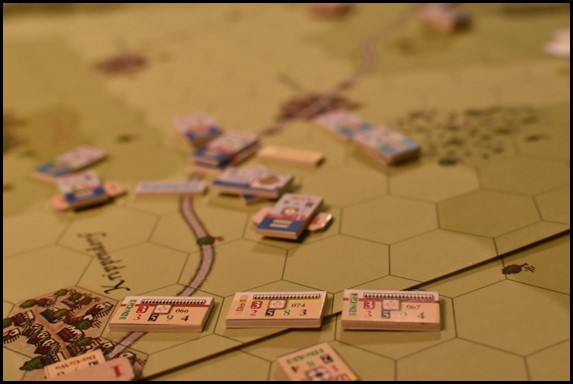
The Prussian and Saxons fall back, French opportunity fire is ineffective. A new defensive line is established, the artillery moves on behind the infantry seeking an advantageous position.
Taunzien detachment’s fatigue was now at 3.
With the time fast approaching 7:30am the Saxon grenadiers, which started the battle defending Closewitz, attempted to rally within the relative safety Krippendorf. Their rally was successful and so the Prussians gained a toehold in the tactically important village with some good order infantry.
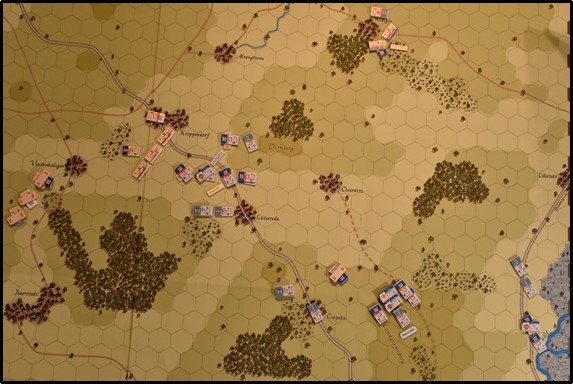
Overview of the battlefield just before 7:30 am.
7:30 French Turn
Lannes’ Corps were now feeing the fatigue after an hour and a half of near constant fighting (morale modifier of -1 due to their fatigue) but with his units being of good morale (9) he decided to press the attack… The fog was still too thick to launch the cavalry but the Saxon infantry were now all within striking range of all his infantry.
The cavalry swept around both flanks of the Saxon line, French columns propelled themselves in the Saxon lines. Lannes concentrated forces on the slightly lower morale 5th Line Infantry. The French guns scrambled to keep up with the pace of the advance.
The French columns were met by a hail of shot as they approached the enemy line with many men falling from the 88th & 103rd Infantry, however the columns did not waver in their determination to engage the Saxons. The French 103rd attacked the 4th Saxon Grenadiers but were promptly repulsed. As they retreated they passed through a horse artillery unit causing that also to fall back disorganized. In the centre, where Lannes had concentrated his attack, the 17th Light and 88th Line made short work of the defending Saxon 5th Line, who fell back disorganized. Lannes advanced despite being flanked on either side by Saxons, relying on his leadership skills (combat and morale modifiers) to hold firm if counter-attacked. The hardest fighting was on the French right, the 100th line joined melee with the Saxon 3rd Grenadiers. Both sides took significant casualties but neither gave ground. In the village of Krippendorf, the French 21st Light who had lately occupied the south-east end of the village, assaulted the recently rallied Saxon grenadiers and attempted to expel them completely from the village, despite causing casualties to the small grenadier unit it was the French resolve which wavered and were themselves driven out from their toe-hold in Krippendorf.
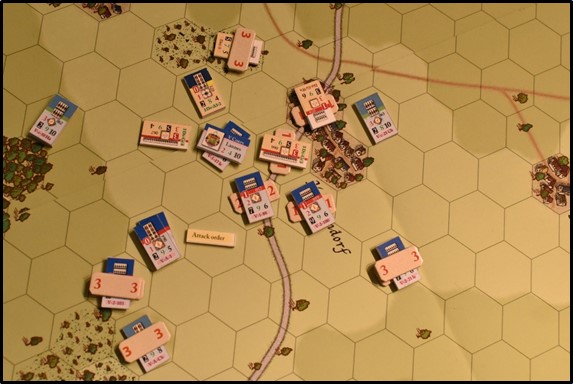
A mixed picture for the French, Lannes has made progress in the centre, but on either flank the Saxons held. The French were expelled from the village of Krippendorf after an inept attack from the 21st Light Infantry. The ace Lannes was still holding was his light cavalry swarming around both Saxon flanks…
Lannes fatigue was now eight, another two and his corps would drop by two morale.
Elsewhere, Augereau and his accompanying forces arrived. Napoleon conscious that Hohenlohe will soon realise this was a major attack, issued the following orders:
Augereau orders:
-
Primary order: Tactic: march. Objective: move and deploy south-west of Krippendorf. Conditions: Leave space for Lannes to deploy to your right
-
Secondary order, if primary order succeeds: Tactic: Defence. Objective: form defensive line at position and await further orders. Conditions: none
-
Secondary order, if primary fails: Tactic: defence. Objective: establish defensive line around Lutzeroda. Conditions: none.
Soult and Ney continued their march.
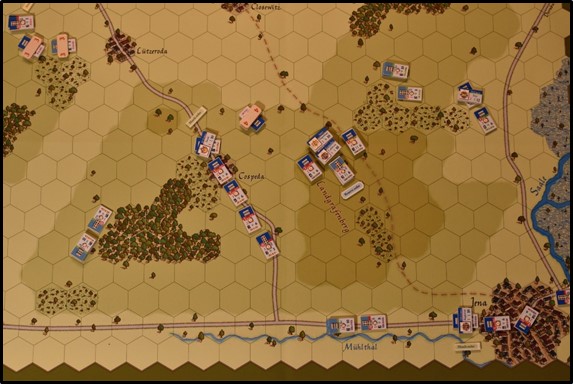
French reinforcements stream onto the field of battle.
7:30 Prussian turn
Taunzien, believing that Lannes had over-reached himself by advancing into the Saxon lines ordered the 4th Grenadiers to attack the 17th Light Infantry from the flank. French fire, from units still in attack column, caused few casualties. Prussian artillery and fire from the 4th Grenadiers caused more casualties on the French 17th Light, but due to Lannes presence they held their ground. The Grenadiers then advanced into the 17th‘s flank – the ensuing melee caused horrendous casualties to the French but again under Lannes direct leadership the attack was eventually repulsed.
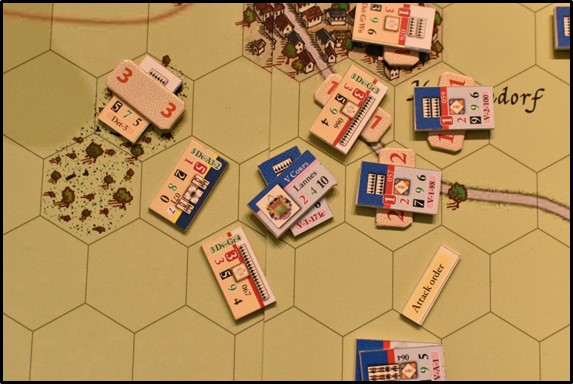
Lannes and the 17th light infantry found themselves first fired upon by Prussian guns and then assaulted in the flank by Saxon grenadiers. Despite suffering staggering casualties Lannes prevented the French from falling back and the Saxon attack was eventually repulsed.
Taunzien desperately needed some of his disorganized troops, particularly his cavalry, to rally but only the Saxon 12th Line Infantry returned to good order. The fatigue of his detachment rose to 4.
